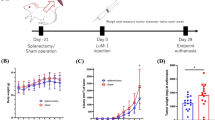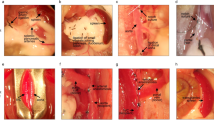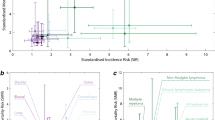Abstract
Prior splenectomy increased the resistance of BALB/c mice to a syngeneic methylcholanthrene-induced ascitic tumour inoculated i.p. The survival rate of splenectomized mice was 81-6% while those of normal and sham-operated controls were 11-5% and 20% respectively. The effect of splenectomy, however, was seen only within the dose range of 10(3) to 10(4) tumour cells. This effect of splenectomy was abolished by the transfer to mice of serum from tumour-bearing mice, and of spleen cells from normal donors, immediately after the inoculation of tumour cells. Cell-free ascitis fluid did not abolish the effect of splenectomy. The findings suggest that there is a subpopulation of spleen cells which produces a tumour growth enhancing factor which is found in the serum of tumour-bearing mice.
This is a preview of subscription content, access via your institution
Access options
Subscribe to this journal
Receive 24 print issues and online access
$259.00 per year
only $10.79 per issue
Buy this article
- Purchase on Springer Link
- Instant access to full article PDF
Prices may be subject to local taxes which are calculated during checkout
Similar content being viewed by others
Rights and permissions
About this article
Cite this article
Chang, R., Turk, J. Increased resistance in splenectomized mice to a methylcholanthrene-induced tumour. Br J Cancer 35, 768–776 (1977). https://doi.org/10.1038/bjc.1977.118
Issue Date:
DOI: https://doi.org/10.1038/bjc.1977.118
This article is cited by
-
The paradoxical effects of splenectomy on tumor growth
Theoretical Biology and Medical Modelling (2006)
-
Potential detrimental effects of rodent viral infections on long-term experiments
Veterinary Research Communications (1988)
-
The role of the spleen in tumor bearing host: II. The influence of splenectomy in mice
The Japanese Journal of Surgery (1984)
-
Bidirectional effects of splenectomy on the growth of syngeneic tumor in mice
The Japanese Journal of Surgery (1984)
-
Effect of regional or distant lymph node removal and of splenectomy on immunologic responses in Ehrlich tumor-bearing mice
The Japanese Journal of Surgery (1982)



